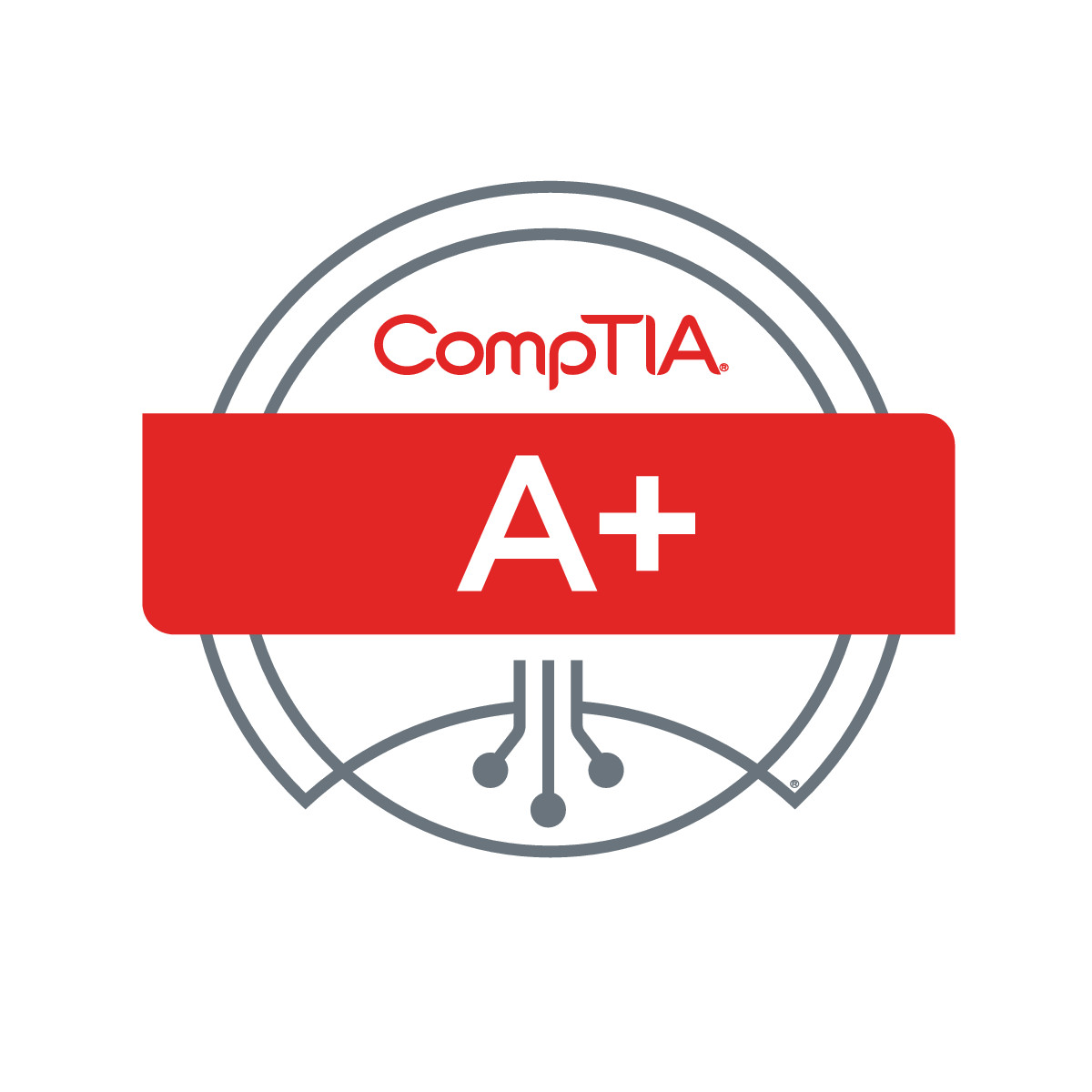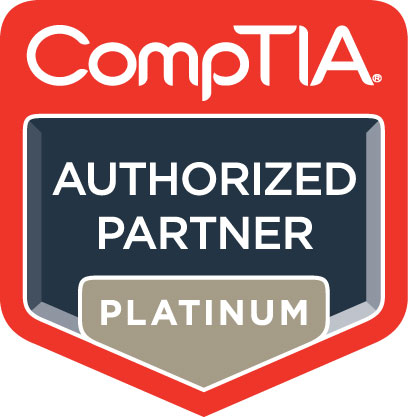Course Outline

CompTIA A+ Day
 CTIA-1101 | Day | 12 Days
CTIA-1101 | Day | 12 DaysIf you are getting ready for a career as an entry-level information technology (IT) professional or computer service technician, the CompTIA A+ course is the first step in your preparation. The course will build on your existing user-level knowledge and experience with personal computer (PC) software and hardware to present fundamental skills and concepts that you will use on the job. In this course, you will acquire the essential skills and information you will need to install, configure, optimize, troubleshoot, repair, upgrade, and perform preventive maintenance on PCs, digital devices, and operating systems.
The CompTIA A+ course can benefit you in two ways. Whether you work or plan to work in a mobile or corporate environment where you have a high level of face-to-face customer interaction, where client communication and client training are important, or in an environment with limited customer interaction and an emphasis on hardware activities, this course provides the background knowledge and skills you will require to be a successful A+ technician. It can also assist you if you are preparing to take the CompTIA A+ certification examinations, 2019 objectives (exam numbers 220-1001 and 220-1002), in order to become a CompTIA A+ Certified Professional.
Click here to find your place on the CompTIA pathway.
Upcoming Dates:
- Jan 26, 2026 - Feb 06, 2026
- Mar 16, 2026 - Mar 27, 2026
- May 04, 2026 - May 15, 2026
- Jul 06, 2026 - Jul 17, 2026
- Sep 14, 2026 - Sep 25, 2026


Who should take this course
This course is designed for individuals who have basic computer user skills and who are interested in obtaining a job as an entry-level IT technician. This course is also designed for students who are seeking the CompTIA A+ certification and who want to prepare for the CompTIA A+ 220-1001 Certification Exam and the CompTIA 220-1002 Certification Exams.
Course Objectives
After completing this course, students will be able to:
- Identify the hardware components of personal computers and mobile digital devices.
- Identify the basic components and functions of operating systems.
- Identify networking and security fundamentals.
- Identify the operational procedures that should be followed by professional PC technicians.
- Install, configure, and troubleshoot display devices.
- Install and configure peripheral components.
- Manage system components.
- Manage data storage.
- Optimize and maintain Microsoft Windows.
- Work with other operating systems.
- Identify the hardware and software requirements for client environment configurations.
- Identify network technologies.
- Install and configure networking capabilities.
- Support mobile digital devices.
- Support printers and multifunction devices.
- Identify security threats, vulnerabilities, and controls.
- Implement security controls.
- Troubleshoot system-wide issues.
Course Outline
Section 1: Hardware Fundamentals
- Personal Computer Components
- Storage Devices
- Mobile Digital Devices
- Connection Interfaces
Section 2: Operating System Fundamentals
- PC and Mobile Operating Systems
- PC Operating System Tools and Utilities
Section 3: Networking and Security Fundamentals
- Network Types
- Network Compenents
- Common Network Services
- Cloud Concepts
- Security Fundamentals
Section 4: Safety and Operational Procedures
- Basic Maintenance Tools and Techniques
- Personal and Electrical Safety
- Environmental Safety and Materials Handling
- Professionalism and Communication
- Organizational Policies and Procedures
- Troubleshooting Theories
Section 5: Supporting Display Devices
- Install Display Devices
- Configure Display Devices
- Troubleshoot Video and Display Devices
Section 6: Installing and Configuring Peripheral Components
- Install and Configure Input Devices
- Install and Configure Output Devices
- Install and Configure Input/Output Devices
- Install and Configure Expansion Cards
Section 7: Managing System Components
- Identify Motherboard Components and Features
- Install and Configure CPUļæ½s and Coolings Systems
- Install Power Supplies
- Troubleshoot System Components
Section 8: Managing Data Storage
- Identify RAM Types and Features
- Troubleshoot RAM Issues
- Install and Configure Storage Devices
- Configure the System Firmware
- Troubleshoot Hard Drives and RAID Arrays
Section 9: Installing and Configuring Microsoft Windows
- Implement Client-Side Virtualization
- Install Microsoft Windows
- Use Microsoft Windows
- Configure Microsoft Windows
- Upgrade Microsoft Windows
Section 10: Optimizing and Maintaining Microsoft Windows
- Optimize Microsoft Windows
- Back Up and Restore System Data
- Perform Disk Maintenance
- Update Software
Section 11: Working With Other Operating Systems
- The OS X Operating System
- The Linux Operating System
Section 12: Customized Client Environments
- Types of Common Business Clients
- Custom Client Environments
Section 13: Networking Technologies
- TCP/IP Problems and Characteristics
- TCP/IP
- Internet Connections
- Ports and Protocols
- Networking Tools
Section 14: Installing and Configuring Networking Capabilities
- Configure Basic Windows Networking
- Configure Network Parameters
- Using Windows Networking Features
- Install and Configure SOHO Networks
Section 15: Supporting Mobile Digital Devices
- Install and Configure Exterior Laptop Components
- Install and Configure Interior Laptop Components
- Other Mobile Devices
- Mobile Device Accessories and Ports
- Mobile Device Connectivity
- Mobile Device Synchronization
- Troubleshoot Mobile Device Hardware
Section 16: Supporting Printers and Multifunction Devices
- Printers and Multifunction Devices
- Install and Configure Printers
- Maintain Printers
- Troubleshoot Printers
Section 17: Security Threats, Vulnerabilities, and Controls
- Common Security Threats and Vulnerabilities
- General Security Controls
- Mobile Security Controls
- Data Destruction and Disposal Methods
Section 18: Implementing Security Controls
- Secure Operating Systems
- Secure Workstations
- Secure SOHO Networks
- Secure Mobile Devices
Section 19: Troubleshooting System-Wide Issues
- Troubleshoot PC Operating Systems
- Troubleshoot Mobile Device Operating Systems and Applications
- Troubleshoot Wired and Wireless Networks
- Troubleshoot Common Security Issues





















